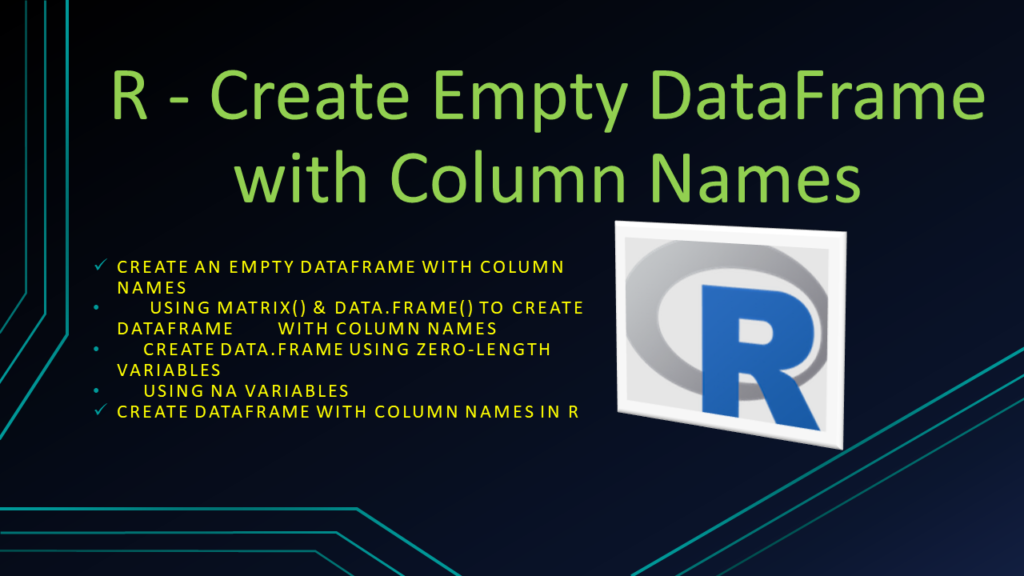Let’s see how to create an empty DataFrame with column names in the R programming language by using data.frame() function. Sometimes, you would be required to assign a column name while creating a DataFrame or assigning names right after creating it.
Here, I will cover several examples of creating an empty DataFrame with column names.
1. Quick Examples of Creating an Empty DataFrame with Column Names in R
Following are quick examples of how to create an empty DataFrame with column names in R.
# Example 1
# Create a Empty DataFrame with 0 rows and n columns
columns = c("id","name","dob")
df = data.frame(matrix(nrow = 0, ncol = length(columns)))
colnames(df) = columns
df
# Example 2
df2 = data.frame(id=numeric(0),name=character(0),dob=character(0))
df2
# Example 3
df3 = data.frame(id=NA, name=NA, dob=NA)[numeric(0), ]
df3
2. Create an Empty DataFrame with Column Names
We are often required to create an empty DataFrame with column names and R provides several ways to achieve this. In this section, I will show different examples of how to create a DataFrame with column names in the R programming language.
2.1 Using matrix() & data.frame() to create DataFrame with Column Names
Since we need column names on DataFrame, let’s create a vector with column names first, c() is used to create a Vector in R. Now, let’s create an empty DataFrame by using the data.frame() function. Finally, print the DataFrame and check if it is really created empty with column names.
# Create a Vector with Columns
columns = c("id","name","dob")
#Create a Empty DataFrame with 0 rows and n columns
df = data.frame(matrix(nrow = 0, ncol = length(columns)))
# Assign column names
colnames(df) = columns
# print DataFrame
print(df)
# Output
#[1] id name dob
#<0 rows> (or 0-length row.names)
# Display Dimension
dim(df)
# Output
# [1] 0 3
As you see above, our DataFrame has 0 rows with 3 columns id, name and dob.
2.2 Create data.frame using Zero-Length Variables
You can also create a DataFrame with column names by using data.frame() and by using zero-length variables.
# Another way
df2 = data.frame(id=numeric(0),name=character(0),dob=character(0))
print(df2)
# Output
#[1] id name dob
#<0 rows> (or 0-length row.names)
2.3 Using NA Variables
Finally, let’s assign a NA to columns in order to create an empty DataFrame with column names.
# Create Empty DataFrame with column names
df3 = data.frame(id=NA, name=NA, dob=NA)[numeric(0), ]
print(df3)
# Output
#[1] id name dob
#<0 rows> (or 0-length row.names)
3. Create DataFrame with Column Names in R
Now let’s see an example of how to create a R DataFrame with column names.
# Create DataFrame
df <- data.frame(
id = c(10,11,12,13),
name = c('sai','ram','deepika','sahithi'),
dob = as.Date(c('1990-10-02','1981-3-24','1987-6-14','1985-8-16'))
)
# Print DataFrame
df
Yields below output.
# Output
id name dob
1 10 sai 1990-10-02
2 11 ram 1981-03-24
3 12 deepika 1987-06-14
4 13 sahithi 1985-08-16
4. Conclusion
In this article, you have learned how to create an empty DataFrame with column names and create a non-empty with column names.
Related Articles
- Create an R DataFrame from Vectors
- Create an R DataFrame from List
- How to Create Empty Vector in R
- Create Character Vector in R
- R – Create DataFrame from Existing DataFrame
- R – How to Create an Empty DataFrame?
